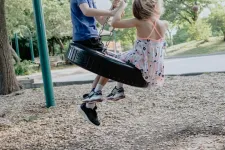(Press-News.org) Children are protected from severe COVID-19 because their innate immune system is quick to attack the virus, a new study has found.
The research led by the Murdoch Children's Research Institute (MCRI) and published in Nature Communications, found that specialised cells in a child's immune system rapidly target the new coronavirus (SARS-CoV-2).
MCRI's Dr Melanie Neeland said the reasons why children have mild COVID-19 disease compared to adults, and the immune mechanisms underpinning this protection, were unknown until this study.
"Children are less likely to become infected with the virus and up to a third are asymptomatic, which is strikingly different to the higher prevalence and severity observed in children for most other respiratory viruses," she said.
"Understanding the underlying age-related differences in the severity of COVID-19 will provide important insights and opportunities for prevention and treatment, both for COVID-19 and possible future pandemics."
The study involved an analysis of blood samples from 48 children and 70 adults across 28 Melbourne households infected with, or exposed to, the new coronavirus. Immune responses were monitored during the acute phase of infection and up to two months afterwards.
Francesca Orsini and Alessandro Bartesaghi took part in the study along with their two daughters, Beatrice and Camilla, after all tested positive to COVID-19.
Both daughters, aged six and two, only had a mild runny nose but Francesca and Alessandro had extreme fatigue, headaches, muscle pain and loss of appetite and sense of taste. It took Francesca and Alessandro at least a fortnight to fully recover.
Dr Neeland said the study showed that children with COVID-19 have a more robust innate immune response to the virus compared to adults.
"Coronavirus infection in children was characterised by activation of neutrophils, the specialised white blood cell that helps heal damaged tissues and resolves infections, and a reduction in first-responder immune cells such as monocytes, dendritic cells and natural killer cells from the blood," she said. "This suggests these infection-fighting immune cells are migrating to infection sites, quickly clearing the virus before it has a chance to really take hold."
"This shows that the innate immune system, our first line of defence against germs, is crucial to prevent severe COVID-19 in children. Importantly, this immune reaction was not replicated among adults in the study."
But Dr Neeland said children and adults who were exposed to, but tested negative for the coronavirus also had altered immune responses.
"Both kids and adults had increased neutrophil numbers, out to seven weeks after exposure to the virus, which could have provided a level of protection from disease," she said.
The study confirms previous MCRI research that found three children in a Melbourne family developed a similar immune response after prolonged exposure to the coronavirus from their parents.
The research stated although the children had been infected with the coronavirus, they were able to mount an immune response which was highly effective in stopping the virus from replicating, meaning they never returned a positive test.
INFORMATION:
Researchers from the University of Melbourne and The Royal Children's Hospital also contributed to the study.
Publication: Melanie R. Neeland, Samantha Bannister, Vanessa Clifford, Kate Dohle, Kim Mulholland, Philip Sutton, Nigel Curtis, Andrew C. Steer, David P. Burgner, Nigel W. Crawford, Shidan Tosif and Richard Saffery. 'Innate cell profiles during the acute and convalescent phase of SARS-CoV-2 infection in children,' Nature Communications. DOI: 10.1038/s41467-021-21414-x
Available for interview:
Dr Melanie Neeland
Dr Shidan Tosif
Professor Richard Saffery, MCRI Group Leader Infection and Immunity
Francesca Orsini and Alessandro Bartesaghi, family involved in the study
A new study, published in Bioscience, considers the future of ecology, where technological advancement towards a multidimensional science will continue to fundamentally shift the way we view, explore, and conceptualize the natural world.
The study, co-led by Greg Asner, Director of the Arizona State University Center for Global Discovery and Conservation Science, in collaboration with Auburn University, the Oxford Seascape Ecology Lab, and other partners, demonstrates how the integration of remotely sensed 3D information holds great potential to provide new ecological insights on land and in the oceans.
Scientific research into 3D digital applications in ecology has grown in the last decade. Landscape ...
With every passing day, human technology becomes more refined and we become slightly better equipped to look deeper into biological processes and molecular and cellular structures, thereby gaining greater understanding of mechanisms underlying diseases such as cancer, Alzheimer's, and others.
Today, nanoimaging, one such cutting-edge technology, is widely used to structurally characterize subcellular components and cellular molecules such as cholesterol and fatty acids. But it is not without its limitations, as Professor Dae Won Moon of Daegu Gyeongbuk Institute of Technology (DGIST), Korea, lead scientist in a recent groundbreaking study advancing the field, explains: "Most advanced nanoimaging techniques use accelerated electron or ion beams ...
Messenger RNA (mRNA) vaccines to prevent COVID-19 have made headlines around the world recently, but scientists have also been working on mRNA vaccines to treat or prevent other diseases, including some forms of cancer. Now, researchers reporting in ACS' Nano Letters have developed a hydrogel that, when injected into mice with melanoma, slowly released RNA nanovaccines that shrank tumors and kept them from metastasizing.
Cancer immunotherapy vaccines work similarly to mRNA vaccines for COVID-19, except they activate the immune system to attack tumors instead of a virus. These vaccines contain mRNA that encodes proteins made specifically by tumor cells. When the mRNA enters antigen-presenting cells, they begin making the tumor protein and displaying it on their surfaces, ...
Swimming in indoor or outdoor pools is a healthy form of exercise and recreation for many people. However, studies have linked compounds that arise from chlorine disinfection of the pools to respiratory problems, including asthma, in avid swimmers. Now, researchers reporting in ACS' Environmental Science & Technology have found that using a complementary form of disinfection, known as copper-silver ionization (CSI), can decrease disinfection byproducts and cell toxicity of chlorinated swimming pool water.
Disinfecting swimming pool water is necessary to inactivate harmful pathogens. Although an effective ...
Washington, February 17, 2021--As higher education institutions worldwide transition to new methods of instruction, including the use of more pre-recorded videos, in response to the COVID-19 pandemic, many observers are concerned that student learning is suffering as a result. However, a new comprehensive review of research offers some positive news for college students. The authors found that, in many cases, replacing teaching methods with pre-recorded videos leads to small improvements in learning and that supplementing existing content with videos results in strong learning benefits. The study ...
Geologists have developed a new theory about the state of Earth billions of years ago after examining the very old rocks formed in the Earth's mantle below the continents.
Assistant Professor Emma Tomlinson from Trinity College Dublin and Queensland University of Technology's Professor Balz Kamber have just published their research in leading international journal, Nature Communications.
The seven continents on Earth today are each built around a stable interior called a craton, and geologists believe that craton stabilisation some 2.5 - 3 billion years ago was critical to the emergence of land masses on Earth.
Little is known about how cratons and their supporting ...
A pioneering study of U.S nitrogen use in agriculture has identified 20 places across the country where farmers, government, and citizens should target nitrogen reduction efforts.
Nitrogen from fertilizer and manure is essential for crop growth, but in high levels can cause a host of problems, including coastal "dead zones", freshwater pollution, poor air quality, biodiversity loss, and greenhouse gas emissions.
The 20 nitrogen "hotspots of opportunity" represent a whopping 63% of the total surplus nitrogen balance in U.S. croplands, but only 24% of U.S. cropland area. In total, ...
Modern medical technology is helping scholars tell a more nuanced story about the fate of an ancient king whose violent death indirectly led to the reunification of Egypt in the 16th century BC. The research was published in Frontiers in Medicine.
Pharaoh Seqenenre-Taa-II, the Brave, briefly ruled over Southern Egypt during the country's occupation by the Hyksos, a foriegn dynasty that held power across the kingdom for about a century (c. 1650-1550 BCE). In his attempt to oust the Hyskos, Seqenenre-Taa-II was killed. Scholars have debated the exact nature of the pharaoh's death since his mummy was first discovered and studied in the 1880s.
These and subsequent examinations -- including an X-ray study in the 1960s -- noted the dead king had suffered several severe head injuries but no ...
Although interest in studying prosocial behaviors among U.S. Latinx individuals has increased recently, there is still limited existing research with this population. Evidence shows that prosocial behaviors (actions intended to benefit others) are a marker of healthy social functioning and can both support positive development (such as academic achievement) and mitigate problematic outcomes (such as anxiety and depression). An important question is whether prosocial behavior is fostered by parents in ways that are specific to their cultural groups or through more universal aspects of parenting. A new longitudinal study in the United States examined relations among parenting, culture, and prosocial behaviors in U.S. Mexican youth.
The findings were published in a Child ...
Children raised in neighborhoods with low socio-economic status are at risk for low academic achievement. A new longitudinal study followed young children from such neighborhoods from birth until age seven to explore whether children's capacity to act kindly or generously towards others (prosocial behavior) - including peers, teachers, and family - is linked to their ability to perform well in school. The study showed that prosocial behavior may mitigate academic risk across early childhood.
The findings were published in a Child Development article written by researchers at Stanford University and the University of Leeds, and the Bradford Institute for Health Research.
"Identifying factors that can help children achieve academic ...





